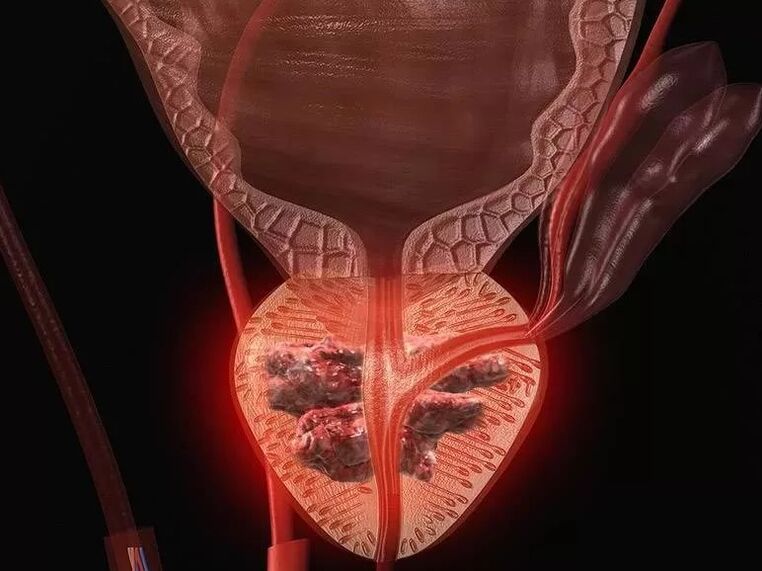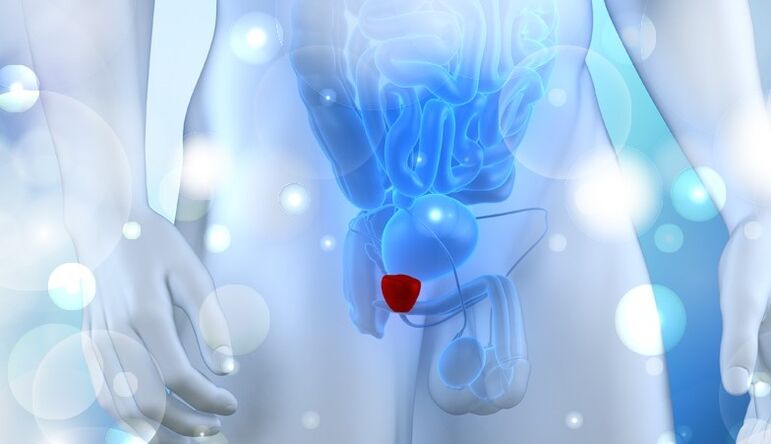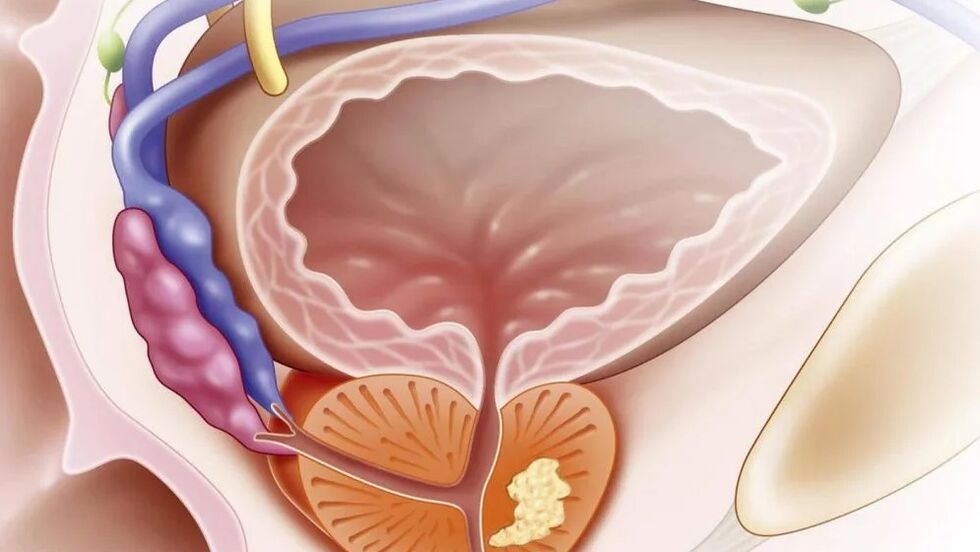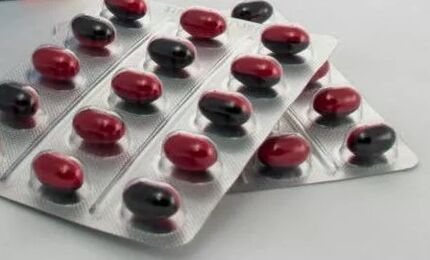One of the most dangerous complications of acute prostatitis can be an abscess of the prostate gland. This is a focal purulent inflammation, to which body temperature can rise to 40 degrees. The signs of the abscess are acute intensive pains and difficult urination. In the absence of medical care, the swelling of the glandular tissues develops and the urethra light is completely blocked.

Prostatitis is the most common urological pathology in reproductive men. According to the polls, every third at least once in his life has had symptoms that can be interpreted as inflammation of the prostate gland. The main cause of the development of bacterial prostatitis is an infection, however, only in the case of acute prostatitis, the infection leads to a strong inflammation of the prostate gland, which is explained by the anatomical characteristics of the structure of the male body.
In the chronic form of prostatitis, the infection can also be the cause, the triggering mechanism of inflammation, but the inflammation of the prostate gland, which requires treatment, can only develop against the background of other factors:
- Prolonged hypothermia of a different nature: it can be both a bathroom in an ice hole, and sitting on cold stones, etc. ;
- The sedentary lifestyle (sedentary), leading to the stagnation of the blood, which can also cause inflammation;
- Irregular sex life: it refers to both excessive abstinence and excessive activity;
- Urological transfer (urethritis, for example) or sexually transmitted (gonorrhea, clamidia, etc. ) disease: there is also a hidden presence of these diseases, whose result becomes prostatitis;
- Regular problems with feces (very often chronic constipation);
- The use of spicy, smoked and brine, alcohol and some other products can also cause inflammation of the prostate gland
- Other factors that cause compromised immunity: excessive loads, multiple or long stress.
Prostatitis: consequences
In case of premature appeal for the urologist, acute bacterial prostatitis can lead to the formation of an abscess and edema of the prostate gland, which is able not only to complicate urination, but to make it completely impossible.
The latter, such as inflammation, can cause serious body intoxication, characterized, among other things, from a strong increase in temperature up to 40-41 ° C (with fluctuations at acute temperature to 1 degree).
However, most of the time you can avoid complications of this type, since the manifestations of prostatitis of this kind usually force the patient not to delay the visit to a specialist.
In the case of a chronic form of the disease, whose symptoms are not so pronounced, the development of complications without adequate and timely treatment is completely possible. Without an appropriate drug and therapeutic effect, inflammation can spread to other organs of the parental parent system, which can lead to development:
- cystitis - inflammation of the bladder;
- Pyelonephritis - Renal inflammation;
- bladder - inflammation of seed bubbles;
- Inflammation of the testicles and appendages of the testicles.

It should be remembered that inflammation of eggs and testicles is one of the most common complications and can cause male infertility, which, in turn, is treated for a long time, difficult and not always successful, therefore faster to treat prostatitis, more possibility to avoid complications of this type.
In some cases, the consequence of chronic prostatitis may be its transition to a form of calculation. The calculation prostatitis is characterized by the formation of calculations (small pebbles) in the excavation ducts of the gland, to get rid of which it is very drug.
In addition, the cause of prostatitis is an hormonal insufficiency caused by insufficient production of hormones with sexual glands.
The development of prostatitis is facilitated by a series of some causes. Very often, the signs of prostatitis manifest themselves in those men who lead an irregular sex life, often suffer hypothermia and injuries.
In addition, prostatitis can develop following a decrease in immunity, worsening the blood flow and the circulation of the sap in the men of the small man's pelvis, following a hormonal failure, which causes a certain level of androgynous insufficiency.
A factor that contributes to the manifestation of prostatitis is also considered a series of infections that are transmitted sexually. Therefore, prostatitis often manifests itself in men after unprotected relationships.
There are 4 main forms of prostatitis: acute bacterial prostatitis, chronic bacterial prostatitis, non -abotterica prostatitis and prostatinia.
In people under the age of 35, the disease usually proceeds in the form of acute bacterial prostatitis. Bacterial prostatitis is called when there is a laboratory confirmation of the presence of infection.
Very often, it turns out to be chlamydia, tricomoniasis, gardenellosis or gonorrhea. The infection enters the prostate gland of the urethra, bladder, rectum, through the blood and lymphatic vessels of the pelvis.

However, recent studies show that in most cases, the infection is stratified on the disorders existing in the structure of the fabric of the prostate and blood circulation in it. With non -kissing prostatitis, bacteria cannot be isolated, although this does not exclude their presence.
In older patients, chronic forms of the disease are more often diagnosed. Prostitodinia is called the presence of a clinical picture of prostatitis, a seal of prostate tissue without signs of its inflammation.
Classification
In accordance with the criteria of the American National Institute of Health (NiH USA), four categories of prostatitis have been distinguished since 1995:
- Acute prostatitis (bacterial)
- Chronic bacterial prostatitis
- Non -bacterial chronic prostatitis / chronic pelvic pain (CP / CPPS)
- Chronic inflammatory pelvic pain syndrome (leukocytes are determined in the secret of the prostate, urine and ejaculating)
- Chronic non -inflammatory pelvic pain syndrome, in which signs of inflammation are absent
- Chronic asymptomatic prostatitis
There has been currently an international classification of prostatitis, which is the most complete and covers all types of inflammation:
- Category I. Acute prostatitis;
- Category II. Chronic bacterial prostatitis;
- Category III. Chronic nebatteric prostatitis/chronic pelvic pain syndrome is a disease in which an infection that lasts more than 3 months is not detected;
Sottocastoria III A. chronic inflammatory pelvic pain syndrome (leukocytes are determined in the secret of the prostate);
Sottocastoria III B. chronic non -inflammatory pelvic pain syndrome (there are no leukocytes in the secret of the prostate); - Category IV. Chronic prostatitis that proceeds speepomically (leukocytes are present in the secret of the prostate, the patient does not make complaints, the disease is detected by chance).
The treatment of prostatitis varies according to the form of the disease in a man. Therefore, bacterial prostatitis can occur both acute and chronic disease.
Quite often, non -kiss prostatitis is also diagnosed as a chronic disorder. Such a variety of prostatitis is also called chronic pelvic pain syndrome.
In such patients, all the characteristic symptoms of prostatitis are observed, but there are no bacteria in the secret of the prostate.
Acute bacterial prostatitis is characterized by rapid development. At the same time, a person suffers from severe pain, there are signs of general intoxication. Symptoms in the chronic form of the disease occur much less clearly. In this case, the disease manifests itself gradually.
And if the course of the prostatitis of the acute form, as a rule, ends with the complete healing of the disease, therefore with chronic prostatitis, recurrence appear quite often. This should be taken into consideration in the treatment of prostatitis at home. In addition, in the presence of inflamed calculations in the prostate gland, disease therapy is a more complex process.

With non -kissing prostatitis (chronic pelvic pain), a person develops severe pain located in the pelvic area, in the genitalia and perineum. There are no signs of inflammation in the prostate.
This disease is common among modern men of different age groups, but very often the disorder affects people of 35-45 years. To date, experts express different hypotheses on what the causes of this form of prostatitis are.
Therefore, there is a theory that this syndrome causes damage to the tissues of a bacterial prostate. In addition, there is an opinion that the disease manifests itself due to the fall of the urine in the prostate gland.
As we have already said, the acute and chronic course of the disease is possible. In this case, the appearance of acute prostatitis is often caused by gram-negative bacteria.
This form of the disease is relatively easy to diagnose and treat taking antibiotics. At the same time, cases of non -kiss chronic prostatitis are very often among men, which is more difficult to diagnose and has no link with a certain infectious injury.
Therefore, in the case of chronic prostatitis, the treatment with antibiotics will not be able to give the adequate effect. According to statistics, about 35% of men over the age of fifty years, chronic prostatitis.
Treatment of chronic and acute prostatitis
In the case of signs of prostatitis, both acute and chronic, it is necessary to consult a urologist, which establishes which type of diagnosis takes place and will also help cure the disease and strengthen the body as a whole. It should be remembered that this also applies to both types of prostatitis, each of which can lead to its complications.
Primary reception
The primary welcome of a specialist involves an investigation and examination of the patient (including the rectal, which allows to determine the degree and nature of the increase in the prostate gland), as well as the appointment of the necessary tests and other diagnostic measures.
The first and important sign of prostatitis is the compromised urination that causes discomfort. Another sign of the disease is rapid urination, but in which urine comes out in small portions.
Acute shape symptoms of the disease

The disease suddenly forms and is characterized by pronounced manifestations.
- frequent painful urination;
- pain during defecation;
- compromised power;
- Inguine pain, in the sacred area and in the anus;
- high sweating;
- fatigue.
Each male body is individual and the symptoms can manifest themselves separately or all at once.
Signs of a chronic form of the disease
Chronic prostatitis is generally characterized by the same signs, however it proceeds with less pronounced symptoms.
In addition, the following events can be observed:
- increase in irritability;
- a feeling of overflowing bladder;
- deterioration of quality or lack of orgasm;
- Selection during defecation from the urethra.
The first signs of prostatitis, to which a man should absolutely pay attention and contact the urologist:
- Severe pain during urination. At the end of the process, there is an unpleasant feeling of combustion.
- Improve body temperature.
- The feeling of not completely emptying the bladder.
- Discomfort in the horse and groin area.
- Insufficient jet pressure during the bathroom visit.
The treatment of prostatitis is carried out according to the form of the disease. Acute inflammation is an indication for hospitalization in the hospital in the urological hospital, with chronic patients undergoing the course of home therapy. If the cause of the disease was a sexual transmission infection, both partners should take antibiotics.
In the treatment of acute prostatitis, it is important that the systemic antibacterial treatment is important.

The main drug groups include:
- Antibiotics. Used in the form of tablets, capsules, candles, syrups and other types.
- Anti -inflammatory drugs.
- Spasmalgotics and analgesics.
- Preparations to increase immunity.
- Vitamins.
- Anti -stress medicine.
Massage
This procedure is one of the most effective methods for the treatment of prostatitis. Thanks to her, accumulated in the prostate gland, the secret is crushed by it and then removed independently through the urethra. In addition, prostate massage helps to improve the blood flow to the tissue of the glands, which increases the effectiveness of antibacterial and local therapy.
Physiotherapy
Physiotherapy treatment helps to improve the trophism of the fabric of the prostate gland and accelerate the recovery process. The following physiotherapy methods are possible:
- transrectal microwave hyperthermia,
- Diadinamophoresi,
- laser therapy,
- Ultrasound sounds.
Exercise
The main signs of the disease
A disease like prostatitis in most men suddenly develops. In the patient, the temperature increases sharply, a feeling of weakness appears, fever. The main sign of prostate inflammation is an intense pain in the perineum, which gives the pubic area, anal opening, sacred. During urination, defecation and with any other tension of the pelvic muscles, the pain increases.































